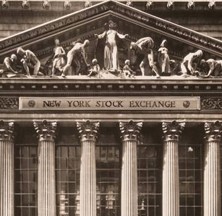PROSPERITY

In a 1925 political cartoon, a confident Uncle Sam stands atop the "Peak of Prosperity," hoisting a triumphant banner labeled "Highest Standard of Living in the History of the World." Behind him, on a pile of ancient ruins, stands Ancient Rome, calling out to Uncle Sam to "Watch your step!" In mid-decade, however, it seemed unthinkable to most Americans that the nation's astounding prosperity was unstable, that its rebound from the severe postwar depression was heading anywhere but up. After all, Americans were producing, selling, advertising, consuming, embracing credit—and investing "on margin" in the stock market—with unquenchable enthusiasm. Amidst the ballyhoo and genuine pride, words of warning were acknowledged, then forgotten. "We have today in these United States, cheek by jowl, Prosperity and Depression," asserted black leader W. E. B. Du Bois. Many Americans had been left behind in the boisterous expansion of the middle class, especially farmers, factory laborers, and minorities. Union labor campaigned for legitimacy and a "living wage," often resorting to strikes which antagonized the general public and fueled anxiety that the nation was under attack from subversive radicals and anarchists. A sinister "us vs. them" cloud hovered in the otherwise blue skies of American confidence. Not all was well. Ancient Rome warned, "Watch your step."*
Framing Questions
- What factors nurtured or weakened the unprecedented prosperity of the 1920s?
- How did "prosperity" become a hallmark of national pride? How was the word adapted for political and psychological aspirations of the nation?
- What role did "workingmen" and labor unions play in the economic panorama of the period?
- Compare the Twenties' boom-and-bust with similar economic cycles before and after the decade.
Sections in PROSPERITY
Each section presents primary resources, introductory notes, classroom discussion questions, and supplemental links.
- "Age of Prosperity"
- - Collected commentary on economic prosperity, 1921-1936
- - Political cartoons (12); cartoonist analysis chart
- Business
- - Collected commentary, 1920-1936
- - Bruce Barton, The Man Nobody Knows: A Discovery of the Real Jesus, 1925, excerpts
- Consumerism
- - Collected commentary, 1924-1931
- - Florine Stettheimer, The Cathedrals of Fifth Avenue, oil on canvas, 1931
- - Humorists on advertising
- - Robert Benchley, "How to Sell Goods," New York World, May 10, 1920
- - Will Rogers, syndicated column on advertising slogans, April 12, 1925
- - Theater commercials (silent) for flour, hand cleaner, and the electric refrigerator
- Crash
- - Collected commentary on the 1929 stock market crash, 1928-1938
- - Political cartoons (12); cartoonist analysis chart
- Labor Union
- - AFL, Letters to a Bishop, 1920, correspondence between Samuel Gompers and William Quayle, 1920, excerpts
- - AFL Declaration: The Challenge Accepted—Labor Will Not Be Outlawed or Enslaved, 1921, excerpts
- - AFL silent film: Labor's Reward, 1925 (clip, and third reel)
- Labor Strike
- - 1919 Seattle General Strike: coverage from labor and general distribution newspapers
- - Sinclair Lewis, Babbitt, novel, 1922, ch. 27: the labor strike
- - Silent animated cartoons
- - Mutt & Jeff, On Strike, 1920
- - Felix the Cat, Felix Revolts, 1923
*- Edmund Gale, "Watch Your Step," political cartoon, Los Angeles Times, November 14, 1925.
- W. E. B. Du Bois, "The Shape of Fear," The North American Review, June 1926.
Image: New York Stock Exchange, photograph, ca. 1925 (detail). Museum of the City of New York, X2010.11.404. Reproduced by permission.



